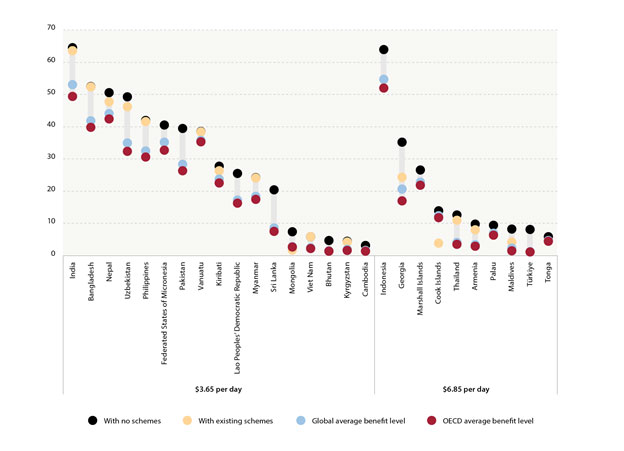
BANGKOK, Thailand, Oct 14 (IPS) - World Food Day 2024. While the impact of COVID-19 and the war in Ukraine on food system disruptions was widely covered, underlying food system vulnerabilities across Asia and the Pacific had been steadily growing long before these crises unfolded.
A comprehensive food-system risk assessment framework and index, INFER, developed by ESCAP and the World Food Programme, points to the rising populations that are particularly exposed to food system disruptions. Of the six recognized dimensions of food security, trends in the risks related to markets and financial policies are the most concerning.
Amid record-breaking food price surges caused by supply chain disruptions and energy price increases, people in the Asia-Pacific region experienced the most significant rise among all regions in the cost of a healthy diet in 2022, leaving approximately one in three people in Asia and the Pacific unable to afford a healthy diet.
There are long-term implications; ill-health is a major contributor to poverty and losses in economic productivity.
The impacts of these recent disruptions underline the need for a closer look at the disruptive potential of climate change. According to ESCAP's Risk and Resilience Portal, over half of the climate impacts are borne by the agriculture sector, due to drought, floods and high temperatures.
East and North-East Asia are at risk of the highest total agricultural losses, exceeding $250 million across all climate scenarios while South-East Asia is expected to experience the greatest GDP impact, with potential agricultural losses reaching up to 6 percent of its GDP.
Climate-related events threaten agricultural output and place immense pressure on the livelihoods of those dependent on the sector. ILO estimates that approximately 363 million people in Asia and the Pacific are employed in the agriculture sector, representing almost one-third of the region's workforce. These workers, the majority of them informally employed and without rights and access to social protection, face heightened risks of income loss and food insecurity.
But the impact of disruptions extends far beyond. Breakdowns in food production, aggregation, processing, distribution and consumption ripple through economies, affecting the livelihoods of millions of people—from urban consumers to small businesses and global markets.
Food system crises impact the poorest households the most as they spend a much higher share of income on food, pushing the near-poor as well as those that had just escaped poverty back into poverty.
The COVID-19 pandemic, which triggered a surge in social protection investments and interventions, demonstrated the critical role of social protection systems in ensuring people's well-being during times of crisis. Universal, life cycle and multi-pillared social protection systems can ensure minimum income security for all people, build their resilience and increase food security.
Non-contributory child or maternity benefit, for example, could mitigate the negative impacts of food insecurity on children and mothers of newborns and safeguard them against climate-induced disruptions in food systems and subsequent crises.
Instead of relying on ad hoc approaches or one-time responses to sudden crises, adaptive and shock-responsive social protection systems, grounded in strong legislative and policy frameworks, offer one of the most effective means of enhancing people's resilience.
By increasing the benefit level or expanding the coverage of existing benefits in the events or following shocks and crisis, these social protection mechanisms—whether through cash transfers or social insurance— help prevent poverty traps and allow communities to recover more quickly.
ILO estimates that that only 55 per cent of the population in Asia and the Pacific has access to at least one social protection benefit, excluding health care, leaving 45 per cent without any protection. According to ESCAP's SPOT Simulator providing universal non-contributory social protection benefits across the lifecycles covering children, persons with disabilities, mothers of newborns, and older persons would reach on average 88 per cent of the population in the countries of Asia and the Pacific and could reduce poverty by up to 84 per cent (figure X).
Despite the potential reach of universal non-contributory social protection benefits and their role as a bulwark against poverty and food insecurity, countries in the region on average spend only 8.2 per cent of GDP on social protection, compared to the global average of 12.9 per cent according to ILO.
Figure X. Simulated impact of various levels of social protection benefits on poverty rates in 27 countries, using international poverty lines

Source: ESCAP SPOT Simulator (2024). Available at https://spot.unescap.org/simulator (accessed on 22 May 2024).
ESCAP's latest flagship publication, Protecting our Future Today: Social Protection in Asia and the Pacific, sets forth social protection as a powerful policy tool to build resilience against future shocks and disruptions that threaten populations across Asia and the Pacific while enabling a just transition to a net-zero emissions future and accelerating inclusive socioeconomic development.
Ongoing megatrends and emerging risks, alongside growing food systems vulnerabilities, will continue to strain the social fabric of Asia and the Pacific, especially for those already in vulnerable situations. In the face of these challenges, the transformative power of social protection will be key to shielding people from future risks, fostering resilience and empowering the people of Asia and the Pacific for a just future.
Areum Han is Associate Social Affairs Officer, Social Development Division, United Nations Economic and Social Commission for Asia and the Pacific (ESCAP).
Yi-Ann Chen is Associate Economic Affairs Officer, Environment and Development Division, United Nations Economic and Social Commission for Asia and the Pacific (ESCAP).
IPS UN Bureau